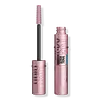What's inside
What's inside
 Key Ingredients
Key Ingredients

 Benefits
Benefits

 Concerns
Concerns

 Ingredients Side-by-side
Ingredients Side-by-side

Water
Skin ConditioningAcrylates Copolymer
Paraffin
PerfumingSynthetic Beeswax
Emulsion StabilisingGlycerin
HumectantPalmitic Acid
EmollientVp/Eicosene Copolymer
Polybutene
Bis-Diglyceryl Polyacyladipate-2
EmollientMica
Cosmetic ColorantAcacia Senegal Gum
MaskingGlyceryl Stearate
EmollientCopernicia Cerifera Wax
Euphorbia Cerifera Wax
Phenoxyethanol
PreservativeStearic Acid
CleansingPEG-100 Stearate
Tocopheryl Acetate
Antioxidant1,2-Hexanediol
Skin ConditioningCaprylyl Glycol
EmollientAlcohol
AntimicrobialPanthenol
Skin ConditioningHydroxyethylcellulose
Emulsion StabilisingIsopropyl Titanium Triisostearate
EmollientPPG-2-Deceth-30
EmulsifyingSodium Hydroxide
BufferingSodium Dehydroacetate
PreservativeDimethicone
EmollientSodium Laureth Sulfate
CleansingSodium Acetate
BufferingIsopropyl Alcohol
SolventPantolactone
HumectantBiotin
AntiseborrhoeicCI 77499
Cosmetic ColorantWater, Acrylates Copolymer, Paraffin, Synthetic Beeswax, Glycerin, Palmitic Acid, Vp/Eicosene Copolymer, Polybutene, Bis-Diglyceryl Polyacyladipate-2, Mica, Acacia Senegal Gum, Glyceryl Stearate, Copernicia Cerifera Wax, Euphorbia Cerifera Wax, Phenoxyethanol, Stearic Acid, PEG-100 Stearate, Tocopheryl Acetate, 1,2-Hexanediol, Caprylyl Glycol, Alcohol, Panthenol, Hydroxyethylcellulose, Isopropyl Titanium Triisostearate, PPG-2-Deceth-30, Sodium Hydroxide, Sodium Dehydroacetate, Dimethicone, Sodium Laureth Sulfate, Sodium Acetate, Isopropyl Alcohol, Pantolactone, Biotin, CI 77499
Isododecane
EmollientCera Alba
EmollientCopernicia Cerifera Cera
EmollientDisteardimonium Hectorite
StabilisingWater
Skin ConditioningAlcohol Denat.
AntimicrobialAllyl Stearate/Va Copolymer
Oryza Sativa Cera
Skin ConditioningParaffin
PerfumingPolyvinyl Laurate
Vp/Eicosene Copolymer
Propylene Carbonate
SolventTalc
AbrasiveSynthetic Beeswax
Emulsion StabilisingEthylenediamine/Stearyl Dimer Dilinoleate Copolymer
Skin ConditioningPEG-30 Glyceryl Stearate
EmulsifyingRayon
Hydrogenated Jojoba Oil
AbrasiveCaprylic/Capric Triglyceride
MaskingSilica
AbrasivePentaerythrityl Tetra-Di-T-Butyl Hydroxyhydrocinnamate
AntioxidantBambusa Vulgaris Extract
Skin ConditioningBHT
AntioxidantCI 77491
Cosmetic ColorantCI 77492
Cosmetic ColorantCI 77499
Cosmetic ColorantCI 77007
Cosmetic ColorantMica
Cosmetic ColorantCI 77891
Cosmetic ColorantCI 75470
Cosmetic ColorantCI 77288
Cosmetic ColorantCI 77742
Cosmetic ColorantCI 77510
Cosmetic ColorantIsododecane, Cera Alba, Copernicia Cerifera Cera, Disteardimonium Hectorite, Water, Alcohol Denat., Allyl Stearate/Va Copolymer, Oryza Sativa Cera, Paraffin, Polyvinyl Laurate, Vp/Eicosene Copolymer, Propylene Carbonate, Talc, Synthetic Beeswax, Ethylenediamine/Stearyl Dimer Dilinoleate Copolymer, PEG-30 Glyceryl Stearate, Rayon, Hydrogenated Jojoba Oil, Caprylic/Capric Triglyceride, Silica, Pentaerythrityl Tetra-Di-T-Butyl Hydroxyhydrocinnamate, Bambusa Vulgaris Extract, BHT, CI 77491, CI 77492, CI 77499, CI 77007, Mica, CI 77891, CI 75470, CI 77288, CI 77742, CI 77510
 Reviews
Reviews

Ingredients Explained
These ingredients are found in both products.
Ingredients higher up in an ingredient list are typically present in a larger amount.
Ci 77499 is also hydrated iron III oxide. It is created from mixing red and black iron oxides. This helps give shades of darkness to a product.
Iron III oxides are classified as inorganic chemicals for coloring.
Mica is a naturally occurring mineral used to add shimmer and color in cosmetics. It can also help improve the texture of a product or give it an opaque, white/silver color.
Serecite is the name for very fine but ragged grains of mica.
This ingredient is often coated with metal oxides like titanium dioxide. Trace amounts of heavy metals may be found in mica, but these metals are not harmful in our personal products.
Mica has been used since prehistoric times throughout the world. Ancient Egyptian, Indian, Greek, Roman, Aztec, and Chinese civilizations have used mica.
Learn more about MicaParaffin is a solid created from petroleum. The term 'paraffin' can also refer to either
petroleum jelly or mineral oil.
It has natural occlusive properties which can worsen oily skin. Due to its petrolatum base, this ingredient is not fungal-acne safe.
Synthetic beeswax is created to be identical in structure to beeswax. It possesses the same occlusive and emulsion properties.
A blend of fatty acid esters, fatty acids, and alcohols are used to create synthetic beeswax. Whether or not this ingredient is vegan depends on the source. Sometimes, lanolin is used for its creation.
This ingredient may not be Malassezia folliculitis, or fungal-acne safe.
Learn more about Synthetic BeeswaxWe don't have a description for Vp/Eicosene Copolymer yet.
Water. It's the most common cosmetic ingredient of all. You'll usually see it at the top of ingredient lists, meaning that it makes up the largest part of the product.
So why is it so popular? Water most often acts as a solvent - this means that it helps dissolve other ingredients into the formulation.
You'll also recognize water as that liquid we all need to stay alive. If you see this, drink a glass of water. Stay hydrated!
Learn more about Water